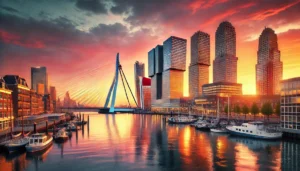Every few years, a technology quietly shifts from being a simple tool to becoming part of the invisible infrastructure that moves the world forward. QR codes have reached that point not through hype, but through the natural way people now interact with information.
What was once a square barcode on a poster has evolved into a flexible, powerful bridge between physical environments and digital experiences. And the most transformative version of this technology is not the static code we see everywhere, but the dynamic QR ecosystem behind it systems like innovative QR code solutions that make information fluid, measurable and adaptable in real time.
This is the future of interaction: not adding more technology into our lives, but making the tools we already use smarter, lighter and more connected.
A Quiet Revolution Happening in Plain Sight
Dynamic QR technology is succeeding for one simple reason:
it doesn’t ask people to change their behaviour.
There is no app to download, no new hardware to buy, no interface to learn.
The one action everyone already knows point, scan, go becomes infinitely more powerful when the content behind it can evolve.
This is technology that fits human nature, not the other way around.
When Physical Space Becomes an Interactive Layer
QR technology has matured far beyond menus and discount codes. The most interesting innovations now happen in places where digital and physical meet:
• Smart packaging that adds storytelling to products
A bottle of wine that reveals its origin, tasting notes, or a greeting from the vineyard team.
• Museums turning exhibits into living experiences
One scan opens interviews, timelines, 3D models experiences that don’t fit on walls.
• Cities guiding residents through services without bureaucracy
Parking, public transport updates, community resources all one scan away.
• Healthcare simplifying instructions and follow-ups
Patients receive the right resources instantly, without navigating portals.
• Manufacturing plants with real-time documentation access
Safety procedures, updates and checklists always reflect the most current version.
These examples share something in common:
they remove friction the biggest enemy of innovation.
Why Dynamic QRs Represent a New Kind of Future-Ready Infrastructure
Innovation is not always about inventing something new.
Sometimes it’s about improving reliability, speed and clarity in the systems we already use.
Dynamic QR technology delivers exactly that:
- Updatable content
A printed code never becomes outdated the destination can change instantly. - Real data from the physical world
Scan insights reveal how people interact with spaces, products and services. - Accessibility across all devices
It works universally, regardless of hardware or operating system. - Low barrier to adoption
Anyone can use it, anywhere, without training.
When a technology offers this combination simplicity, scalability, and universality it quietly becomes foundational.
The Rise of “Soft Innovation”
Not all innovation is loud.
Not all innovation requires new devices, large investments or dramatic reinvention.
Some of the most powerful shifts come from soft innovation:
small, smart changes that upgrade everyday interactions.
Dynamic QR systems are the perfect example of this.
They enhance hospitality, retail, education, manufacturing, healthcare not by replacing these systems, but by strengthening them.
A hotel check-in becomes smoother.
A classroom becomes more interactive.
A store becomes more transparent.
A product becomes more meaningful.
A city becomes easier to navigate.
This is the kind of innovation that compounds quietly over time.
Where Dynamic QR Technology Is Headed Next
The next wave won’t be about new shapes or colours it will be about intelligence.
Here’s where the industry is moving:
1. Context-aware destinations
The same QR may show different content based on time of day, location or user type.
2. Personalised experiences
Product recommendations, onboarding flows or instructions that adapt to each user.
3. Integration with AI assistants
Instructions, manuals and documentation become interactive conversations.
4. Micro-analytics to optimise real-world spaces
Scan data helps retailers, museums and cities improve layout, placement and messaging.
5. Seamless cross-device continuity
Scan on a phone → continue experience on desktop with zero friction.
The humble QR code is becoming part of a much larger, smarter ecosystem one that blends UX, data and accessibility into a single, universal entry point.
A Technology That Doesn’t Demand Anything Except Imagination
What makes dynamic QR technology so special is its neutrality.
It doesn’t define what you must build.
It simply gives you a doorway.
A doorway to:
- information,
- stories,
- community,
- services,
- conversion,
- learning,
- creativity,
- and connection.
Innovation isn’t always about the flashiest invention.
Sometimes it’s about recognising when a familiar tool has evolved into something transformative quietly, steadily, and everywhere.
Dynamic QR technology is one of those tools.
The physical world hasn’t gone away.
It has simply become clickable.














